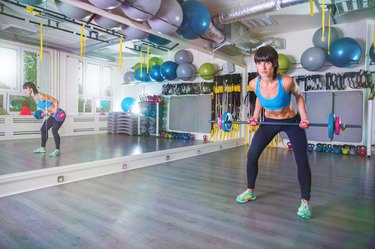
Unless you want to send your fellow gym members scrambling to get out of the way, you have to secure your weights to the barbell. None of the clamps or collars are hard to figure out, but if you're not sure if you're attaching them correctly, ask.
Barbells
Video of the Day
Barbells are long, steel bars with removable weighted plates on each end. One type of barbell has the weights permanently attached to either end. The other type of barbell can hold several disks, ranging in weight between 5 and 100 pounds, but the weights are detachable. Securing your barbell weights keeps them from sliding off the metal bar and causing injury. As described by the International Olympic Committee, collars are the devices that secure barbell weights by tightly encircling the rod outside the weighted plates. The type of collar you use to secure your barbells depends on your preference and the type of barbell.
Video of the Day
Quicklee Collars
A Quicklee collar resembles a 3-inch-long metal or plastic tube with a slightly narrower tube inside the outer layer. These collars work on barbells with either ridged ends, called threaded barbells, and ones with smooth metal ends. To fasten a Quicklee collar, pull the outer layer of the tube away from the interior layer and slide the collar, outer layer first, onto the barbell rod. Release the outer layer, so it covers the interior tube, making the collar tight around the rod. Securing Quicklee collars doesn't require additional tools or tons of arm strength, which makes them useful for beginning weightlifters.
Spin-Lock Collars
Applying a spin-lock collar -- which look like large, two-layered bolts -- correctly requires unscrewing the two layers away from each other so the collar is loose enough to slide on the barbell. Tightening the spin-lock collar requires screwing the layers toward each other until they feel tight. These collars only work on barbells with threaded ends. Spinning the two layers against each other multiple times adds security when holding heavier weights. The downside to these collars is they also require significant body strength to tighten completely.
Clamp Collars
Clamp collars are like pressurized spring coils holding barbell weights in place. A piece of metal is coiled four or five times before branching off into two padded prongs. Squeezing the prongs on the clamp collar loosens the coiled metal so you can slide the clamp on the barbell. Releasing the prongs tightens the coil around the barbell. Clamp collars secure weights on either a smooth or threaded barbells. Although these collars don't take long to apply, squeezing the two prongs requires forearm strength.
Screw-On Collars
Barbells with threaded ends require screw-on collars. The collars have a bolt-shaped upper level with a smooth metal ring on the bottom. Applying a screw-on collar requires loosening the two levels by unscrewing the top piece away from the bottom, then sliding them on the barbell. Screwing the top level toward the bottom metal ring secures the collar in place.
Pressure Collars
A pressure collar is bolt-shaped collar with an attached metal circle beneath and two wing nuts on either side. To secure the collar, slide it on the rod and use pliers to twist each wing nut until it tightens completely around the rod. Pressure collars are the most expensive of all the barbell collars. With proper application, they also offer the greatest security for heavier weight loads. Pressure collars are they type of collars Olympic weightlifters use when competing. For those looking to change weighted plates quickly, understand that pressure collars require additional time to apply properly compared with other types of collars.